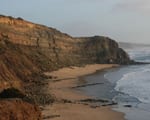The Daily Campus reporter Charlie Scott covered SMU’s contributions to the new Perot Museum of Nature and Science near downtown Dallas. Many fossils from SMU’s Shuler Museum of Paleontology are on loan to the new Perot Museum, including those of animals from an ancient sea that once covered Dallas.
The fossils represent a slice of SMU’s scientific collaboration with the Perot Museum and its predecessor, the Dallas Museum of Natural History.
Items from SMU’s scientists include a 35-foot skeletal cast of the African dinosaur Malawisaurus standing sentry in the spacious glass lobby of the Perot, which opened Dec. 1.
EXCERPT:
By Charlie Scott
The Daily Campus
The land is arid. Its inhabitants undergo crippling heat, little rain and countless droughts.Texas suffers from a shortage of water, but that hasn’t always been the case.
Visitors to the new Perot Museum of Nature and Science in Uptown now have an opportunity to see fossils of animals from a prehistoric time when an ancient sea covered the Big D.
The fossil display, which is made possible by an ongoing collaborative effort between SMU and the Perot Museum, contain “some spectacular pieces that tell some very interesting stories,” according to Anthony Fiorillo, Curator of Earth Sciences at the Perot.
Many of the fossils on display date from a geological period called the Cretaceous, which lasted from 146 million years ago to 66 million years ago.
Some of these are plant fossils that were discovered at a ranch southwest of Fort Worth in Hood County.
Some other fossils on loan from that period, include sea turtles and mosasaurs, which are ancient aquatic lizards that eventually evolved flippers and long bodies for life at sea.
In 2006 a then 5-year-old Preston Smith was on a family outing along the North Sulpher River in Ladonia Texas when she stumbled upon what appeared to be the remnants of a turtle. But this was no ordinary find.When Diana Vineyard, director of administration and research associate at SMU’s Institute for the Study of Earth and Man, got her hands on the specimen as graduate student, she worked to determine the creature had died 80 millions years ago.
She also found that it wasn’t only 1 turtle Smith happened across.
Follow SMUResearch.com on Twitter.
For more information, www.smuresearch.com.
SMU is a nationally ranked private university in Dallas founded 100 years ago. Today, SMU enrolls nearly 11,000 students who benefit from the academic opportunities and international reach of seven degree-granting schools. For more information see www.smu.edu.
SMU has an uplink facility located on campus for live TV, radio, or online interviews. To speak with an SMU expert or book an SMU guest in the studio, call SMU News & Communications at 214-768-7650.


 Study: Most Texas ISDs that are teaching the Bible are skirting 2007 state law
Study: Most Texas ISDs that are teaching the Bible are skirting 2007 state law Study finds Jurassic ecosystems were similar to modern: Animals flourish among lush plants
Study finds Jurassic ecosystems were similar to modern: Animals flourish among lush plants SMU contributes fossils, expertise to new Perot Museum in ongoing scientific collaboration
SMU contributes fossils, expertise to new Perot Museum in ongoing scientific collaboration 100 million-year-old coelacanth discovered in Texas is new fish species from Cretaceous
100 million-year-old coelacanth discovered in Texas is new fish species from Cretaceous Observed! SMU’s LHC physicists confirm new particle; Higgs ‘God particle’ opens new frontier of exploration
Observed! SMU’s LHC physicists confirm new particle; Higgs ‘God particle’ opens new frontier of exploration DOE Award: advancing SMU’s link to the God particle
DOE Award: advancing SMU’s link to the God particle